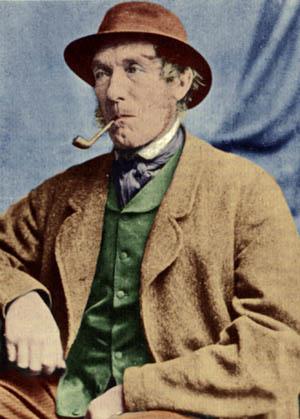

Thanks to the Biggest Liar competition held in his honour every year Will Ritson has become synonymous with telling lies. This is a bit unfair because as he said himself, his lies were never malicious - he just liked to exaggerate. He was basically just a great storyteller who spun a good yarn.
He was born at Row foot in 1808 and brought up as a farmer's lad and thus became immersed in country ways. As was necessary to life in such a remote and sometimes severe part of the country he became skilful at shepherding, angling, and hunting. Being very tall with the strength acquired from manual labour and walking the fells, along with his quick brain, the local pastime of wrestling also became his forte. He also developed the droll sense of humour still found in many farmers today.
His local popularity, however, was propelled to eternal fame when he and his wife Dinah became proprietors and hosts of the Huntsman's Inn. Here his stories developed and reached a wider audience as he entertained some of the first tourists and climbers to the area. These included such worthies as Wordsworth and De Quincey. His incredible tails were no doubt spurred on by the fact that townies often consider themselves in some way superior to country bumpkins whilst usually demonstrating quite the opposite as they flounder in the unfamiliar environment. The trick then is to see how far you can pull their leg before they catch on, and then to persist beyond all credulity to increase their humiliation.
However, once his fame had spread, people visited the Inn not to be deceived but to hear how a master could tell a good tale. One of the more famous stories was about how his father grew a huge turnip, which took all year to hollow out, and the carcass then used as a shed. Not all his tales were original - many being adaptations of local folklore. The following is an account of one of his more subtle anecdotes told to Rev. T. Ellwood from Coniston and recorded in the journal of the Cumberland & Westmorland Antiquarian & Archaeological Society.
"It has from time immemorial been the custom of the people of Wasdale to carry their dead to Eskdale or Nether Wasdale Church for interment, there being no burial ground attached to the church at Wasdale Head. The corpse in the coffin is slung over the back of a horse and carried in this fashion over the fell. On one occasion (lang sen) the wife of a dalesman was being so carried for interment.
When upon the edge of the fell the coffin, through the negligence of the driver of the horse, came in contact with a rowan tree, and was thrown to the ground. By the concussion the coffin was forced open, and the supposed corpse was found to be alive. She returned home with her friends, and lived for several years after. When she died, and the same kind of cavalcade was following her remains in very much the same fashion, as they approached the said rowan tree again, her husband, who was bringing up the rear, called out (according to Will) in stentorian tones " Tak' care o' that rowan tree!" This time, however, the rowan tree was successfully cleared."
Having retired to Nicol Ground in 1879 Will lived to the age of 83 years and was buried in Nether Wasdale churchyard in 1890.
This story was used by Rev. Ellwood as an example of the sacred and magical nature of the Rowan or Mountain Ash. The author was interested in how the customs of Iceland compared with those of Cumbria and thus the connection with Vikings. Another local example of use of the Rowan tree which was also revered in Icelandic culture is how it was used to stir milk to chase away evil spirits that may stop the milk from turning to butter.
© WAWL 2008